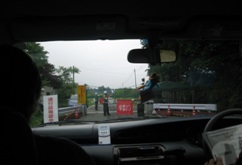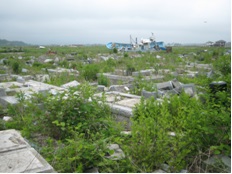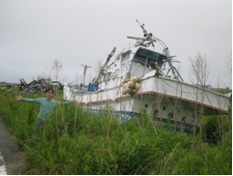
Various forms of applied social psychologyPoints of Contact between Psychology and Society
2013 Yomiuri Shinbun’s “kokoro”[“heart and mind”] page
I have had a column running in the newspaper “Yomiuri Shinbun” since this April. The column that I have been writing is called “kokoro”page, appearing in the first Monday of each month in the evening edition of it.
I used to have a weekly column in the newspaper “Asahi Shinbun”, and having a deadline every week was a kind of fear. That was something you don’t experience in normal everyday life.
Compared to that experience (i.e. having a weekly column), I expected that having a monthly column was relatively comfortable, and I took on the monthly column. However, appearing in the newspaper once a month is too rare for readers to remember the last column. Now I wonder if this is really working as a column RUNNING.
The “kokoro” page tended to feature articles on serious topics at that time, such as views of life and death, so the editor requested me to write about a lighter one.
Applied social psychology and the “kokoro”
There are various fields within psychology, and my specialty is social psychology. Within social psychology, I focus on an area called “applied social psychology.” This is a discipline that considers the actually occurring events and phenomena in society from a psychological perspective.
I have woven several themes together such as “preventing anxiety”, “having a polestar perspective”, “forensic clinical psychology”, “counseling and release”, “do not forget about Fukushima”, and “the wonders of memory”.
Forensic clinical psychologyis one of the topics addressed by social psychology. A project on forensic clinical psychology started at Ritsumeikan University, as a project of Ritsumeikan Global Innovation Research Organization (R-GIRO) in 2012. The project lead by Professor Mitsuyuki Inaba has been pushing forward with the collaborative research and practical social implementation, working to establish the first center of forensic clinical psychology in Japan and aiming at making the center to the one of the greatest in the world. The development of young researchers has also proceeded successfully. Kousuke Wakabayashi and Akinobu Nameda (both the graduates from College of Letters, Ritsumeikan University) received their doctorates in 2013.
In my July Yomiuri Shinbun column, I took up the issue of “forensic psychological assessment”,“criminal forensic assessment” and focused on the fact that, in an era of lay judge trials, if it is not explained that how a defendant who has admitted his or her crime came to commit murder, then ordinary citizens will not understand the case. This was also the finding of research conducted by Ryoichi Hiroi, a professor at this university.
Different ways of writing “Fukushima”
For my August Yomiuri Shinbun column, I wrote an article entitled “Do not forget about Fukushima,”. This was related to the fact that I had been an assistant professor at Fukushima University before coming to Ritsumeikan University.
In June of 2013, with the cooperation of a former colleague, Fukushima University professor Norio Suzuki, I was able to visit the town of Namie in Fukushima Prefecture. At that point in time, most of the town had been designated an “area to which returning will be difficult”, but former residents were being allowed to visit for a short time. I was thus able to visit the area by travelling together with some former residents.

This is a photograph that I took from inside a car. You cannot go through unless you have a travel pass. There are gates on the roads leading to former residential areas and you must go through a checkpoint. Let us put aside for the moment the question of who is to blame. Nevertheless, isn’t it important to make sure that people other than these residents are aware of the fact that the nuclear accident has led to this kind of situation? We must also think about the fact that this sort of thing could happen at any of the nuclear sites in the country if there were an accident.


The photograph on the left is of a graveyard. Two and a half years have passed, and the gravestones struck by the tsunami remain broken. In the background, you can see a fishing boat. It has been like this for two and a half years. It is not clear whether or not it’s the same boat in the picture on the right, but this is what it looks like photographed from up close. In any case, even though a considerable amount of time has passed, this is how it remains.
Of course, recovery in the disaster area on the whole is progressing in places where the level of radiation is not a problem. However, in the area around Fukushima Daiichi nuclear power plant, which is expected to take 40 years to decommision, nothing has been done. And in general, the time limit for compensation requests is three years. Without being able to see the future, what should be defined as damages for which compensation can be sought? This is also an issue that is being addressed by the R-GIRO Center for forensic clinical psychology.
Dr. Ayae Kido, a researcher of R-GIRO, has also focused on the fact that Fukushima is being written in katakana [“Katakana” is a Japanese phonetic script usually used for foreign words or to add emphasis. Place names such as Fukushima are normally written using Chinese characters (“Kanji”)]. She points out that in the area itself, hiragana [a different phonetic script] is used (in the project name “Let’s start from Fukushima”, for example), and suggests that it will perhaps only be when recovery is finished that the normal way of writing the name [in Chinese characters] is used once again. This idea has interested foreign scholars, and I hope that this day will come as soon as possible.
Various forms of applied social psychology
Since this is an applied social psychology project, I would like to examine anything as long as it is related to society. We probably would not have taken up the Fukushima [written in Katakana] problem if there hadn’t been a major earthquake.However, since such a state of affairs has come to pass, it is a problem that must be addressed by someone.
Flexibility is both a strength and a weakness of our project. And what undergirds this flexibility is cultural psychology and its trajectory equifinality model approach. I introduced this topic in my May Yomiuri column.
The trajectory equifinality model approach is a way of thinking about development/maturity that incorporates the fact that there are several routes (trajectories) leading to a described outcome. To think that even after entering a company, you could still go back to university or graduate school is a “multi-trajectory” idea. If there is only one path to the goal that you are aiming for, you will fail if this route is closed off. However, if there are multiple routes, then you will try to think of another way forward even if one is blocked.
This epistemological approach was created at Ritsumeikan University in 2004. It was the result of an intellectual collaboration with Professor Jaan Valsiner, at the time a professor at Clark University in the United States (he is currently a professor at the University of Aalborg in Denmark). Our project has made this new epistemology its flagship, and the various forms of applied social psychology have, while resonating with the flexible thought of young scholars, fostered the development of research that is in keeping with the spirit of Ritsumeikan University. This is something that has been recognized not only inside Japan but also by researchers all over the world.
In the URLs listed below, I have taken this opportunity to provide links to websites introducing researchers from overseas who have visited us at our lab. Ritsumeikan University’s Institute of Human Sciences is becoming the hub of an international network.
References
- Ritsumeikan Global Innovation Research Organization (R-GIRO)
Center for Forensic Clinical Psychology
(https://sites.google.com/site/rgiro2lawpsyc/home) - (Visiting scholars to Sato lab, ver.1 (2004〜2011)
(https://sites.google.com/site/satozemiguest/) - (Visiting scholars to Sato lab, ver.2 (2012〜)
(https://sites.google.com/site/satozemiguest2/home) - Trajectory equifinality model
(http://www.k2.dion.ne.jp/~kokoro/TEM/index.html)








